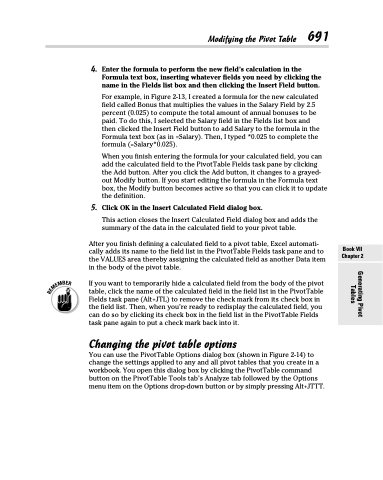Page 709 - Excel 2013 All-in-One For Dummies
P. 709
4. Enter the formula to perform the new field’s calculation in the Formula text box, inserting whatever fields you need by clicking the name in the Fields list box and then clicking the Insert Field button.
For example, in Figure 2-13, I created a formula for the new calculated field called Bonus that multiplies the values in the Salary Field by 2.5 percent (0.025) to compute the total amount of annual bonuses to be paid. To do this, I selected the Salary field in the Fields list box and then clicked the Insert Field button to add Salary to the formula in the Formula text box (as in =Salary). Then, I typed *0.025 to complete the formula (=Salary*0.025).
When you finish entering the formula for your calculated field, you can add the calculated field to the PivotTable Fields task pane by clicking the Add button. After you click the Add button, it changes to a grayed- out Modify button. If you start editing the formula in the Formula text box, the Modify button becomes active so that you can click it to update the definition.
5. Click OK in the Insert Calculated Field dialog box.
This action closes the Insert Calculated Field dialog box and adds the
summary of the data in the calculated field to your pivot table.
After you finish defining a calculated field to a pivot table, Excel automati- cally adds its name to the field list in the PivotTable Fields task pane and to the VALUES area thereby assigning the calculated field as another Data item in the body of the pivot table.
If you want to temporarily hide a calculated field from the body of the pivot table, click the name of the calculated field in the field list in the PivotTable Fields task pane (Alt+JTL) to remove the check mark from its check box in the field list. Then, when you’re ready to redisplay the calculated field, you can do so by clicking its check box in the field list in the PivotTable Fields task pane again to put a check mark back into it.
Changing the pivot table options
You can use the PivotTable Options dialog box (shown in Figure 2-14) to change the settings applied to any and all pivot tables that you create in a workbook. You open this dialog box by clicking the PivotTable command button on the PivotTable Tools tab’s Analyze tab followed by the Options menu item on the Options drop-down button or by simply pressing Alt+JTTT.
Modifying the Pivot Table 691
Book VII Chapter 2
Generating Pivot Tables


